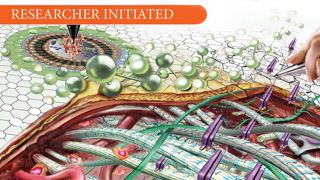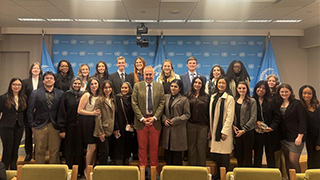Medical Illustrations of Art, Design and Interactive Multimedia Professor Selected for International Competition
Tuesday, April 28, 2020

Professor William Haney, College of Communication and the Arts
William Haney, Professor of Art, Design, and Interactive Multimedia in College of Communication and the Arts, has been recognized by the London International Creative Competition (LICC) for two of his original medical illustrations. The works, "M.E.D. Medical Education Dynamics," and "Biofilm Formation," have been honored in the Illustration and Graphic Design category. This category highlights and exemplifies excellence in information and scientific design with an emphasis on visual learning versus visual aesthetic techniques.
Exhibiting selections digitally each year, the LICC is an annual design contest dedicated to showcasing cutting-edge art from progressive talents that push the boundaries of visual expression. Considering everything from painting and photography to fashion and printmaking, works are submitted from almost every corner of the globe. The 2020 competition was no exception, with approximately 1,287 submissions rated by a panel of twenty-two blind jurors with awards given to only 8 percent of potential entrants. Winning an LICC award offers artists unparalleled worldwide media exposure, meant to strengthen their profile and provide exclusive new professional opportunities.
As the LICC website explains, "Our artists are connected not by conventions, but by qualities... We're not looking for anything done by-the-book. We're looking for work that is as visual as it is vital."
The selected works of Haney encompass the many different disciplines of information design, including business, healthcare, technology, engineering and the arts. The primary goal is to synthesize complex data by organizing and simplifying it so that specific populations and audiences can grasp concepts more easily through visual learning. Haney's digitally rendered medical illustrations are prime examples of this, and are targeted to educate medical professionals, physicians and scientists.

Selected work "M.E.D.
Medical Education Dynamics"
The first digitally rendered work selected by the jury was "M.E.D. Medical Education Dynamics," which depicts the process of implanting dermal host tissue where human skin has been compromised. Depicted through vivid representations of the skin's internal workings, the illustration outlines the compelling choreography of how eight constituents compose a new scaffold skin matrix to remodel human tissue. Haney explains, "It's truly remarkable how the human body recognizes the new host tissue and immediately starts communicating and integrating together, which is the narrative the illustration strives to convey."

Selected work
"Biofilm Formation"
Haney's second selected work, "Biofilm Formation," uniquely illustrates the seven phases of how bacteria grows and multiplies. The first three vignettes intrinsically depict how planktonics form bacteria creating pods that interact and multiply. In the remaining steps, the pod colonies are seen imbued with an antiseptic molecular agent used to interfere with growth migration and deconstruction of the once intact modules.
Beyond the LICC, these illustrations and others created by Haney have been featured in MEDinArt, a digital platform showcasing the work of artists that connect biomedical sciences with technology and the arts. In addition to numerous exhibitions and video projections, MEDinART has hosted several artists to speak at international conferences throughout Europe, including events in Belgium, Denmark, Spain, Switzerland, and Kazakhstan. More high-resolution examples of Haney's work can be seen by way of his artist profile.
After spending decades as a leader in the field of digital art and design, Haney attributes much of his success to a very simple philosophy of emphasizing research as the backbone of information design. As a professor at Seton Hall, Haney instills this philosophy in his students, so they might become better informed artists and designers. "I try to train my students to actively research their subject, understand its structure, and then try to create something that can be visually comprehensible. For students, the development of this process can be challenging as it requires the ability to extract, memorize, and manipulate relevant information in order to build a visual architecture. In conducting such a research process, the students visual analytical skills and personal heuristics become inseparable."
Professor Haney teaches courses in drawing and digital design in the Art, Design and Interactive Multimedia program in the College of Communication and the Arts. For more information, contact Amanda Carcione at [email protected].
Categories: Arts and Culture






